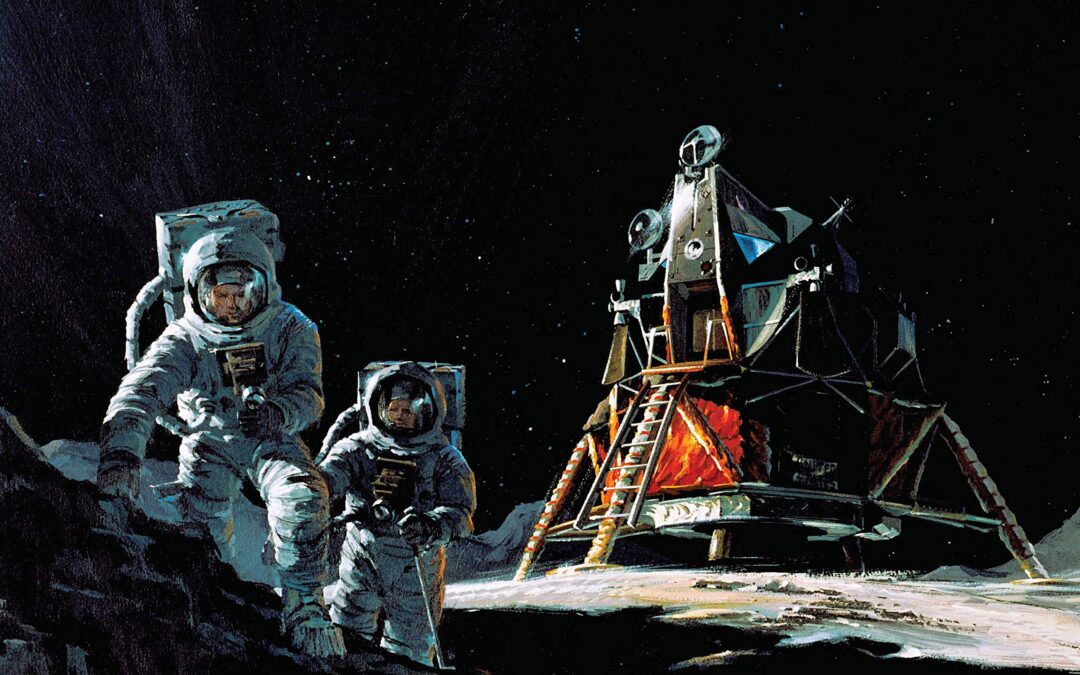
In this expanded collector’s edition of The Art of NASA, complete with a paper model Lunar Module and a poster, explore over 200 stunning artworks commissioned by NASA to sell its missions.
Formed in 1958, NASA has long maintained a department of visual artists to depict the concepts and technologies created in humankind’s quest to explore the final frontier. Culled from a carefully chosen reserve of approximately 3,000 files deep in the NASA archives, the 200+ awe-inspiring illustrations presented in this special boxed edition are complemented by:
- 32 pages of new material
- A paper model of the Lunar Module
- A rolled poster
- A sheet of four postcards
- A new foreword by astronaut Tom Jones
From space suits to capsules, from landing modules to the Space Shuttle, the International Space Station, and more recent concepts for space planes, The Art of NASA presents 60 years of American space exploration in an unprecedented fashion. All the landmark early missions are represented in detail—Gemini, Mercury, Apollo—as are post-Space Race accomplishments, like the mission to Mars and other deep-space explorations.
The insightful text relates the wonderful stories associated with the art. For instance, the incredibly rare early Apollo illustrations show how Apollo might have looked if the landing module had never been developed. Black-and-white Gemini drawings illustrate how the massive NASA art department did its stuff with ink pen and rubdown Letraset textures. Cross-sections of the Apollo–Soyuz Test Project docking adapter reveal Russian sensitivity about US “male” probes “penetrating” their spacecraft, thus the androgynous “adapter” now used universally in space. International Space Station cutaways show how huge the original plan was, but also what was retained.
Every picture in The Art of NASA tells a special story. This collection of the rarest of the rare is not only a unique view of NASA history—it’s a fascinating look at the art of illustration and a glimpse of NASA history like no other.
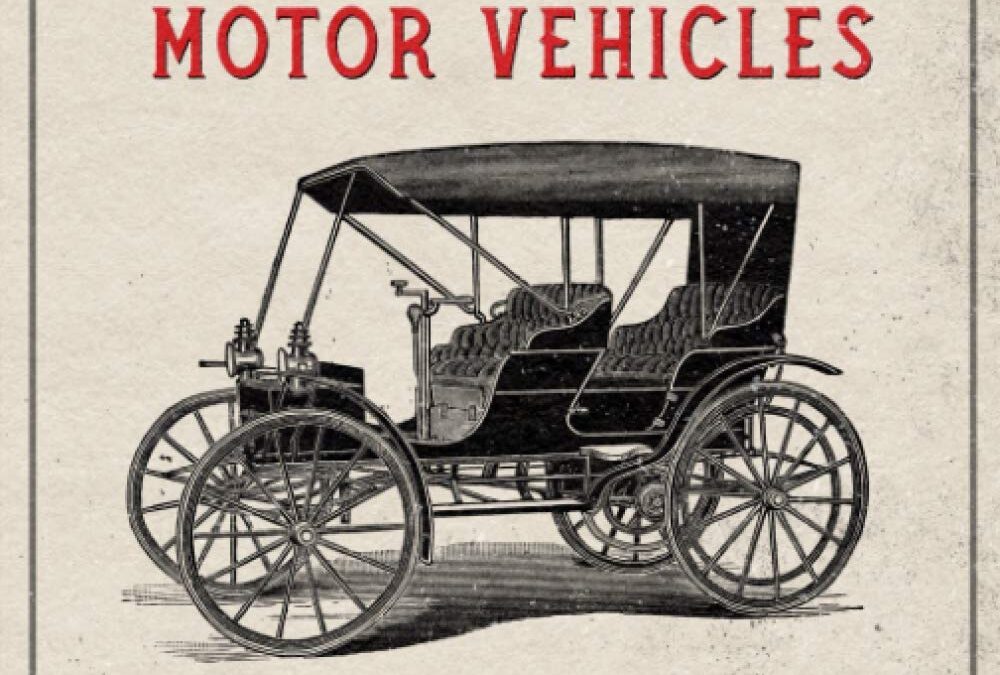
More than 500 detailed illustrations enhance this contemporary guide to the inner workings and mechanics of turn-of-the-century automobiles, trucks, and motorcycles.
Released in 1911 as “Self-Propelled Vehicles: A Practical Treatise,” James Homans’ spectacular, all-encompassing book about the fascinating world of gas-powered, electric-powered, and steam-powered motor vehicles leaves no stone unturned in its celebration of the classic automobile.
Classic car collectors, racers, and enthusiasts will enjoy this thorough look under the hood as Homans dissects every part of the “horseless carriage” from a unique and contemporary viewpoint that offers a keen insight into the bygone age of dramatic motoring. Antique Cars and Motor Vehicles spans more than 640 pages, immersing readers in a world of automotive history, vehicle parts, driving gears, steering, suspension, engines, exhaust, and even old fashioned American road signs.
The hundreds of Images of cars, engines, parts, and mechanic operations are crisp and detailed, created by skilled master artists with a sharp eye for detail. It’s everything that you ever wanted to know about classic motoring in a single, entertaining, and well-illustrated volume!
This enhanced 2020 re-release features enlarged 7” x 10” pages that retain the original classic type font and page layouts, crisp, digitally re-scanned images, and a new retro cover design created to enhance your reading room and garage.
Table of Contents:
Chapter 1 – History of Self-Powered Vehicles
Chapter 2 – The Make-Up of a Motor Carriage
Chapter 3 – Compensation and Compensating Devices
Chapter 4 – The Driving Car
Chapter 5 – The Steering of a Motor Vehicle
Chapter 6 – Combined Steering and Driving
Chapter 7 – The Supports of a Motor Vehicle
Chapter 8 – Motor Carriage Wheels
Chapter 9 – Tires
Chapter 10 – The Construction of Tires
Chapter 11 – Pneumatic Tire Troubles
Chapter 12 – Care of Pneumatic Tires
Chapter 13 – Types and Merits of Automobiles
Chapter 14 – The Theory of Heat Engines
Chapter 15 – The Parts of a Gas Engine
Chapter 16 – The Four-Cycle Gas Engine
Chapter 17 – The Two-Cycle Gas Engine
Chapter 18 – Compression and Expansion
Chapter 19 – Efficiency in a Gas Engine
Chapter 20 – Exhaust
Chapter 21 – Water Cooling for the Cylinder
Chapter 22 – Air Cooling for the Cylinder
Chapter 23 – Power Elements of a Gas Engine
Chapter 24 – Carburetors
Chapter 25 – Ignition
Chapter 26 – Balancing Gasoline Engines
Chapter 27 – Governing and Control of a Gasoline Engine
Chapter 28 – Clutches
Chapter 29 – Transmissions
Chapter 30 – Brakes
Chapter 31 – Roller Bearings
Chapter 32 – Lubricants
Chapter 33 – Practical Operation of Gasoline Engines
Chapter 34 – Motorcycles
Chapter 35 – Steam Engines for Automobiles
Chapter 36 – Boilers and Flash Generators
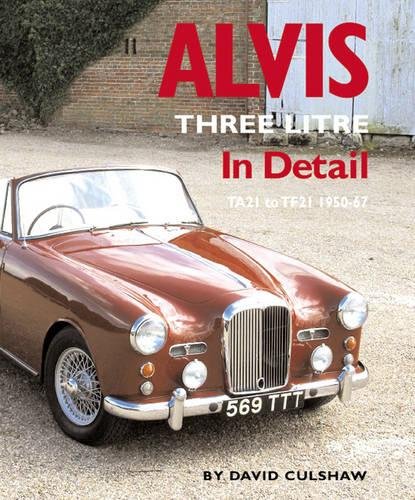
From its launch in 1950 to its demise in 1967, the Alvis Three Litre enjoyed a deserved reputation for effortless performance, exceptional surefootedness and stability, a high degree of driver friendliness, and irreproachable quality of construction. It was considered a rather exclusive car, coming as it did from a maker whose products always had a certain individuality. In addition, there remained through successive models something reassuringly traditional about its styling in both saloon and drophead forms; while never outdated, it displayed a timeless, discreet dignity unmoved by the more frivolous vagaries of fashion. All the while, in the background but ready to serve when called upon, was the Alvis works, whose concern for its cars and their owners was exemplary.Throughout production, the Three Litre was based on the same chassis and was powered by the same engine. This was a handsome and efficient short-stroke six-cylinder, conceived in order to provide the driver with ample power over a very wide rev range. Starting with an output of 83bhp in the early TA21, this robust unit was progressively developed to supply 150bhp in its final TF21 form while retaining the turbine smoothness, reliability and lack of temperament that it had become celebrated for. It was perfectly matched to its chassis and running gear, and those who have driven a Three Litre at speed will find the dynamic qualities of the contemporary rivals from Bentley or Jaguar rather less likeable.This book opens with an exposition of the background that led to the companys introduction of the Three Litre in 1950. Then comes a detailed technical analysis of the TA21, covering all aspects of the chassis, running gear, engine and transmission. This sets the scene for the chapters which follow, on the short-lived TB21 sports tourer, the TC21 and the uprated TC21/100, the Graber-inspired TC108G, the outstandingly handsome TD21 Series I and II, the TE21 and the TF21.Each of these receives comprehensive treatment, including differences from previous models, production changes and full chassis number number listings, along with notes on famous owners and screen appearances. The author provides extensive information on the coachbuilders who supplied Three Litre bodies, including Mulliners, Tickford, Graber, Willowbrook and Park Ward, and there are chapters devoted to the Alvis-powered Healey G Series sports car, the aborted Issigonis-designed Alvis TA350, and the ownership and use of Alvis Three Litre models today.Five outstanding examples of the cars have been specially photographed for this book and are featured in some 70 colour shots. There are also more than 140 black-and-white illustrations drawn from archives as well as from Alvis sales and publicity material. Devoted exclusively to the Three Litre, this book offers an in-depth examination of these excellent cars to provide a store of information for the many owners who care passionately about them, and serve as a tribute to the men who made them.
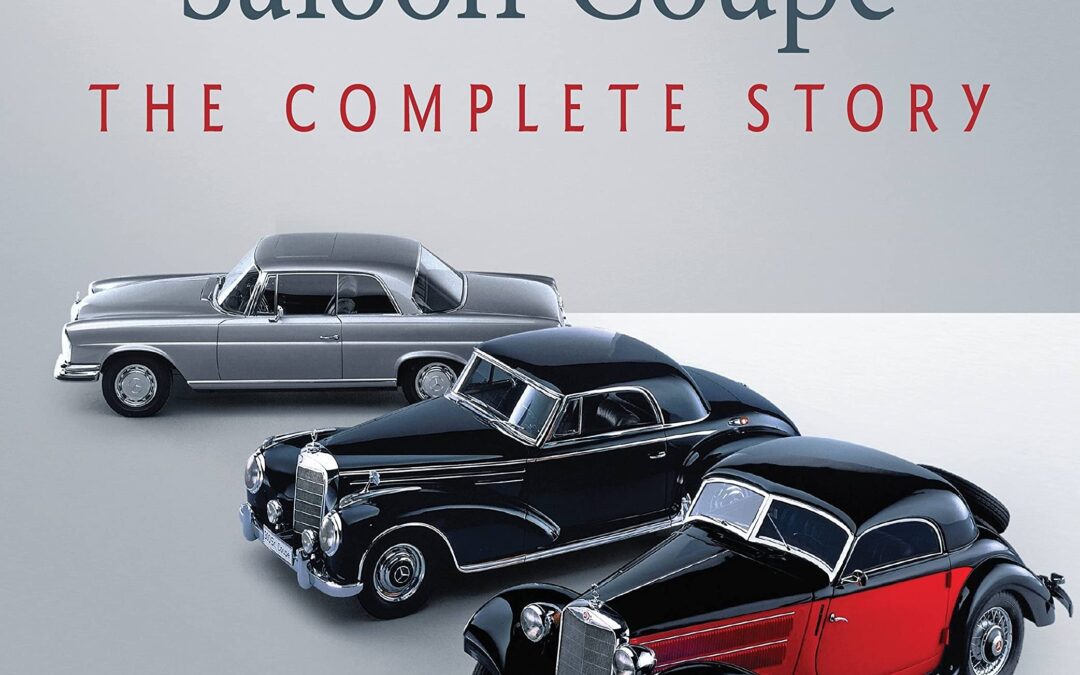
First produced in 1928, Mercedes-Benz Coupés became the embodiment of elegance and exclusivity on four wheels. Their design became an experience for all the senses, appealing to every emotion.
Hans-Dieter Futschik, the designer responsible for many of the later Mercedes-Benz models, said of the Saloon Coupé: ‘A shorter wheelbase compared with the saloons gives it different proportions that are almost sports car-like in character. The passenger compartment is set further back. This gives it a sportier look than a saloon. In addition, the greenhouse is smaller and more streamlined than the basic body. It looks like a small head set on a muscular body, exuding a powerful and more dynamic attitude… Everything radiates power, elegance and agility.’
This complete guide includes an overview of early automotive history; pre-merger design from both Benz and Daimler; the historical protagonists and how they influenced the design; how design and fashion change vehicle shape; the continued development of Saloon Coupe design to suit every class and finally, the modern idea of the Coupe.
With over 200 photographs and illustrations, this book includes:
- An overview of early automotive history
- Pre-merger design from both Benz and Daimler
- The historical protagonists and how they influenced the design
- How design and fashion change vehicle shape
- The continued development of Saloon Coupé design to suit every class
- The modern idea of the Coupé.
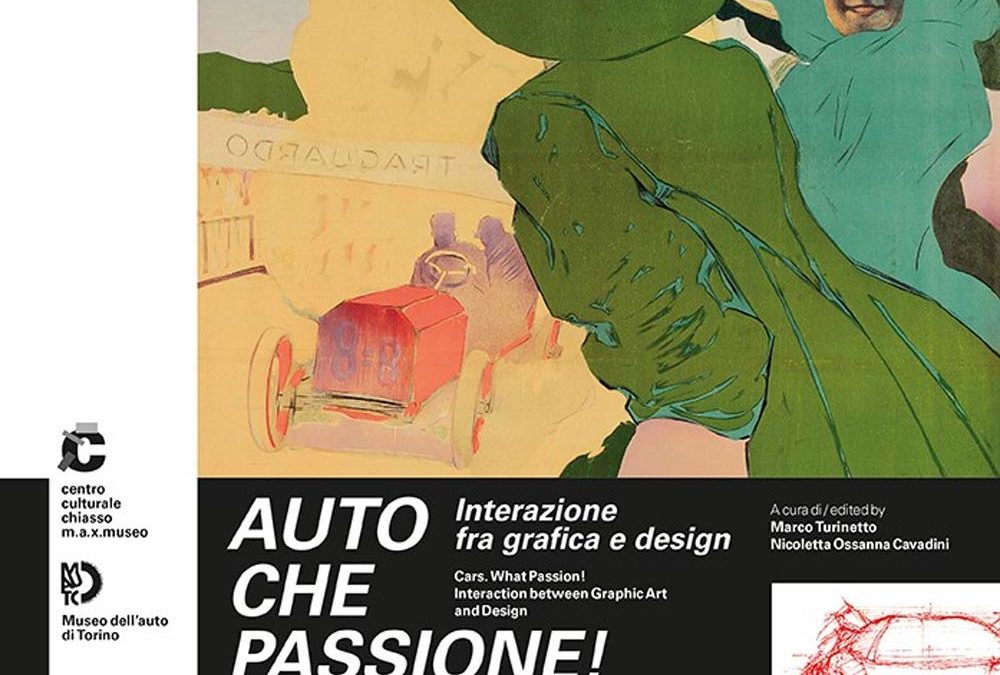
Interaction Between Graphic Art and Design
This volume (with contributions by Maria Canella, Marta Mazza, Nicoletta Ossanna Cavadini, Mario Piazza, Marco Turinetto, Uberto Pietra, Paola Masetta and Ilaria Pani) traces a path that ranges from fashion to periodical publishing, the graphic design of posters, leaflets and postcards to printed media communication, where the complexity of the car as a product appears with its many facets and with all its appeal.
It presents an innovative survey of the theme of the car in which graphics and design are entwined with its various historical phases. This guided tour of cars and stylistic tendencies becomes a comprehensive concept of the “automobile civilization”, so much a part of modern culture, which is analysed through the advertising work that car manufacturers commissioned from the greatest designers: Marcello Dudovich, Leopoldo Metlicovitz, Achille Mauzan, Plinio Codognato, Carlo Biscaretti di Ruffia, Aldo Mazza, Marcello Nizzoli, Max Huber, Giulio Confalonieri and Pierluigi Cerri. The texts are accompanied by a rich collection of illustrations.
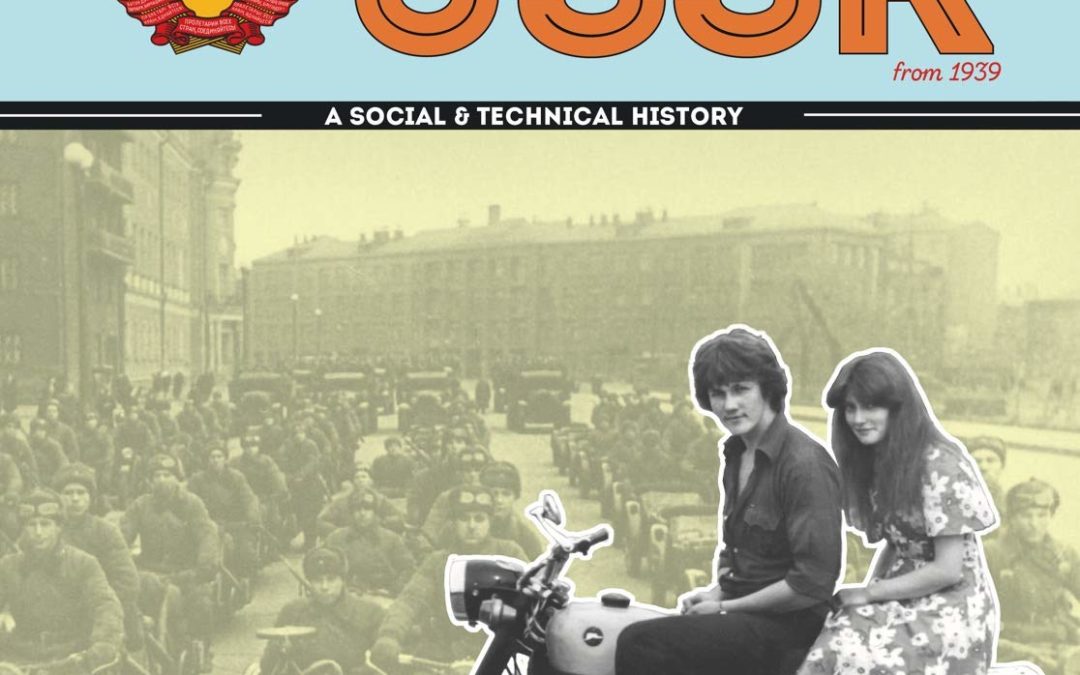
Motorcycles and Motorcycling in the USSR from 1939 provides the first accessible English language account of motorcycles in the Soviet Union. Concentrating on the wartime and postwar period until 1990, prior to the dissolution of the USSR in 1991, it covers the motorcycles produced, and looks at the way in which they were used at home and exported abroad. Chapters cover wartime, models produced, the social character of Soviet era motorcycling, and wide-ranging sport. With planned rather than market-led production based around copies of pre-war German BMW and DKW models, the industry churned out hundreds of thousands of utilitarian and rugged machines that were very different from the more fashion-orientated machines produced in the West. These motorcycles went under the place names of the producing factories: Ishevsk, Kovrov, Moskva, Minsk and, of course, the large flat twins produced in Irbit and Kiev under the Ural and Dnepr names. With a strong emphasis on Soviet era illustrations, the book provides an insight into a life, based on idealism and ideology that has now passed. Photographs and images, many of them from private family collections, show Soviet bikes as well as popular imports Jawa from Czechoslovakia, and Pannonia from Hungary.

“The Belle Epoque (The Beautiful Age) coincides with the period of Edwardian extravagance so well depicted in the now famous TV series “Downton Abbey”. During this era, at the turn of the 20th century, Paris was the epicentre of fashion and art , London of society and class, Vienna of intellectual activity. New York’s own golden age was based on money, that classic American value!
There was an ebullient atmosphere everywhere , decadent and magnificent at the same time, coinciding with the momentous changes brought by modern inventions including wireless communication, the automobile, and the airplane. The privileged and moneyed classes enjoyed lives of extravagant luxury in sharp contrast to the desperate lives of the under classes, urban and rural. This contrast was even more evident in Sicily, where so many still endured medieval conditions. Palermo was one of Europe’s capitals of the period, visited regularly by royalty including the Czar of Russia and Germany’s Kaiser.
During those same years Vincenzo Florio, scion of Sicily’s leading family, created his eponymous race, the Targa Florio. He was only 23 when its first edition took place in 1906, but the honor committee included the presidents of the Automobile Clubs of the United Kingdom, France and Germany. Florio intended Sicily to be at the center of the blossoming new world of auto racing . He succeeded beyond his wildest dreams, and his story is being made into a movie titled ” Pistons, Passions & Sicilian Pleasures”. It will recount the early life of Vincenzo Florio and his friend and protege Felice Nazzaro, destined to become one of the greatest drivers of all time.
As a prelude to the release of the film, Upfolds Publishing announces the publication of the companion book..
The book narrates the experience of making this film. It is rich in illustration both historical and modern. The photographic artist Becca Parker captures both the beautiful landscapes of Sicily and the excitement of one hundred year old racing cars, reliving the passions of the Targa Florio, the oldest race in the world.
The book is a hard covered coffee table style in high definition.
“


